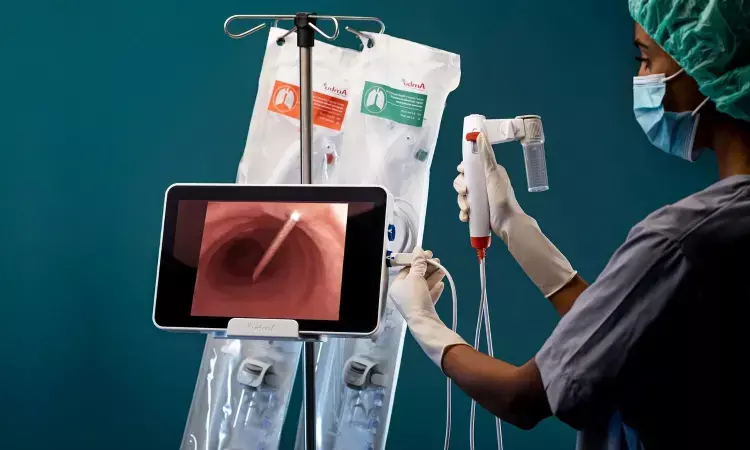- Home
- Medical news & Guidelines
- Anesthesiology
- Cardiology and CTVS
- Critical Care
- Dentistry
- Dermatology
- Diabetes and Endocrinology
- ENT
- Gastroenterology
- Medicine
- Nephrology
- Neurology
- Obstretics-Gynaecology
- Oncology
- Ophthalmology
- Orthopaedics
- Pediatrics-Neonatology
- Psychiatry
- Pulmonology
- Radiology
- Surgery
- Urology
- Laboratory Medicine
- Diet
- Nursing
- Paramedical
- Physiotherapy
- Health news
- Fact Check
- Bone Health Fact Check
- Brain Health Fact Check
- Cancer Related Fact Check
- Child Care Fact Check
- Dental and oral health fact check
- Diabetes and metabolic health fact check
- Diet and Nutrition Fact Check
- Eye and ENT Care Fact Check
- Fitness fact check
- Gut health fact check
- Heart health fact check
- Kidney health fact check
- Medical education fact check
- Men's health fact check
- Respiratory fact check
- Skin and hair care fact check
- Vaccine and Immunization fact check
- Women's health fact check
- AYUSH
- State News
- Andaman and Nicobar Islands
- Andhra Pradesh
- Arunachal Pradesh
- Assam
- Bihar
- Chandigarh
- Chattisgarh
- Dadra and Nagar Haveli
- Daman and Diu
- Delhi
- Goa
- Gujarat
- Haryana
- Himachal Pradesh
- Jammu & Kashmir
- Jharkhand
- Karnataka
- Kerala
- Ladakh
- Lakshadweep
- Madhya Pradesh
- Maharashtra
- Manipur
- Meghalaya
- Mizoram
- Nagaland
- Odisha
- Puducherry
- Punjab
- Rajasthan
- Sikkim
- Tamil Nadu
- Telangana
- Tripura
- Uttar Pradesh
- Uttrakhand
- West Bengal
- Medical Education
- Industry
Navigational bronchoscopy effective in diagnosing peripheral pulmonary nodules: NEJM

A new study published in The New England Journal of Medicine found that for patients with peripheral pulmonary nodules ranging in size from 10 to 30 mm, the diagnostic accuracy of transthoracic needle biopsy was not inferior to that of navigational bronchoscopy.
The majority of lung nodules are benign, but some are malignant, and when detected. To differentiate benign from malignant lung nodules, an accurate biopsy is frequently necessary. The most widely used technique to date, CT-guided transthoracic needle biopsy, has a high risk of complications, with over 25% of patients experiencing pneumothorax, or partial lung collapse. A chest tube is frequently needed during a multi-day inpatient stay to treat a partly collapsed lung. In order to examine the effectiveness of transthoracic needle biopsy and navigational bronchoscopy for lung nodules, Robert Lentz and colleagues carried out this investigation.
This study assigned patients with an intermediate-risk or high-risk peripheral pulmonary nodule with a diameter of 10 to 30 mm to have either a transthoracic needle biopsy or a navigational bronchoscopy at 7 different U.S. centers as part of this trial. The percentage of patients with biopsies that revealed a particular diagnosis (cancer or a certain benign illness) that was verified to be accurate after a year of clinical follow-up (noninferiority margin, 10 percentage points) was the main result, and it was known as diagnostic accuracy. The incidence of pneumothorax and other procedural problems were secondary outcomes.
Of the 234 patients in the primary-outcome analysis, 5 were lost to follow-up. Of these, 94 out of 119 patients (79.0%) in the navigational bronchoscopy group and 81 out of 110 patients (73.6%) in the transthoracic needle biopsy group received a specific diagnosis from biopsy that was confirmed to be accurate through month 12.
32 of 113 patients (28.3%) in the transthoracic needle biopsy group and 4 of 121 patients (3.3%) in the navigational bronchoscopy group had pneumothorax, which resulted in the insertion of a chest tube, hospitalization, or both in 13 patients (11.5%) and 1 patient (0.8%), respectively.
Overall, for the diagnosis of lung nodules, navigational bronchoscopy is just as successful as the conventional transthoracic needle biopsy, but it has a lot less side effects. This discovery has the potential to change medical procedures and lower hospital stays for individuals having lung nodule biopsies.
Source:
Lentz, R. J., Frederick-Dyer, K., Planz, V. B., Koyama, T., Aboudara, M. C., Avasarala, S. K., Casey, J. D., Cheng, G. Z., D’Haese, P.-F., Duke, J. D., Grogan, E. L., Hoopman, T. C., Johnson, J., Katsis, J. M., Kurman, J. S., Low, S.-W., Mahmood, K., Rickman, O. B., Roller, L., … Interventional Pulmonary Outcomes Group. (2025). Navigational bronchoscopy or transthoracic needle biopsy for lung nodules. The New England Journal of Medicine. https://doi.org/10.1056/NEJMoa2414059
Neuroscience Masters graduate
Jacinthlyn Sylvia, a Neuroscience Master's graduate from Chennai has worked extensively in deciphering the neurobiology of cognition and motor control in aging. She also has spread-out exposure to Neurosurgery from her Bachelor’s. She is currently involved in active Neuro-Oncology research. She is an upcoming neuroscientist with a fiery passion for writing. Her news cover at Medical Dialogues feature recent discoveries and updates from the healthcare and biomedical research fields. She can be reached at editorial@medicaldialogues.in
Dr Kamal Kant Kohli-MBBS, DTCD- a chest specialist with more than 30 years of practice and a flair for writing clinical articles, Dr Kamal Kant Kohli joined Medical Dialogues as a Chief Editor of Medical News. Besides writing articles, as an editor, he proofreads and verifies all the medical content published on Medical Dialogues including those coming from journals, studies,medical conferences,guidelines etc. Email: drkohli@medicaldialogues.in. Contact no. 011-43720751


